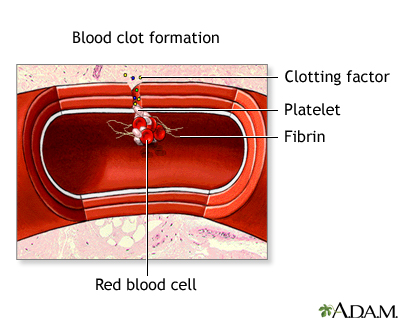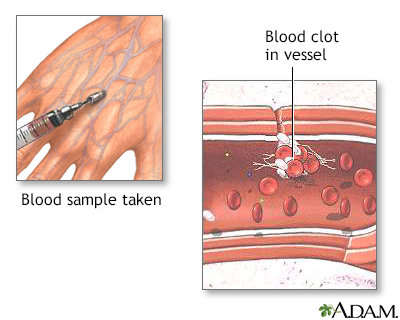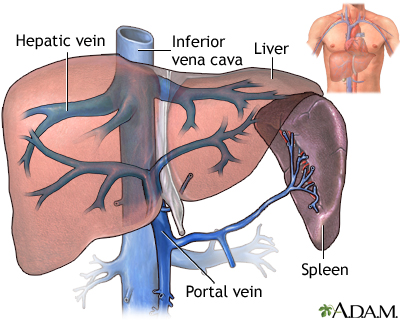Hepatic vein obstruction (Budd-Chiari)
Budd-Chiari syndrome; Hepatic veno-occlusive disease
Hepatic vein obstruction is a blockage of the

The esophagus, stomach, large and small intestine, aided by the liver, gallbladder and pancreas convert the nutritive components of food into energy and break down the non-nutritive components into waste to be excreted.

The digestive system organs in the abdominal cavity include the liver, gallbladder, stomach, small intestine and large intestine.

Blood clotting normally occurs when there is damage to a blood vessel. Platelets immediately begin to adhere to the cut edges of the vessel and release chemicals to attract even more platelets. A platelet plug is formed, and the external bleeding stops. Next, small molecules, called clotting factors, cause strands of blood-borne materials, called fibrin, to stick together and seal the inside of the wound. Eventually, the cut blood vessel heals and the blood clot dissolves after a few days.

Blood clots (fibrin clots) are the clumps that result when blood coagulates.

The portal vein drains blood from the intestine, stomach, spleen, pancreas, and gallbladder into the liver. The liver processes the nutrients in this blood and filters out toxic substances. The hepatic veins then carry the blood away from the liver and into the inferior vena cava, which leads to the right atrium, one of the four chambers of the heart.
Causes
Hepatic vein obstruction prevents blood from flowing out of the liver and back to the heart. This blockage can cause liver damage. Obstruction of this vein can be caused by a tumor or growth pressing on the vessel, or by a clot in the vessel (hepatic vein thrombosis).
Most often, it is caused by conditions that make blood clots more likely to form, including:
- Abnormal growth of cells in the bone marrow (myeloproliferative disorders)
- Cancers
- Chronic inflammatory or autoimmune diseases
- Infections
- Inherited (hereditary) or acquired problems with excessive blood clotting
- Oral contraceptives
- Pregnancy
Hepatic vein blockage is the most common cause of Budd-Chiari syndrome.
Symptoms
Symptoms include:
- Abdominal swelling or stretching due to fluid in the abdomen
- Pain in the right upper abdomen
- Vomiting blood
- Yellowing of the skin (jaundice)
Exams and Tests
One of the signs is swelling of the abdomen from fluid buildup (
Tests include:
CT scan orMRI of the abdomen - Doppler ultrasound of the liver veins
Liver biopsy Liver function tests Ultrasound of the liver
Treatment
Treatment varies, depending on the cause of the blockage.
Your health care provider may recommend the following medicines:
- Blood thinners (anticoagulants)
- Clot-busting medicines (thrombolytic treatment)
- Medicines to treat the liver disease, including ascites
Surgery may be recommended. This may involve:
- Angioplasty and stent placement
- Transjugular intrahepatic portosystemic shunt (TIPS)
- Venous shunt surgery
- Liver transplant
Possible Complications
Hepatic vein obstruction can get worse and lead to cirrhosis and liver failure. This can be life threatening.
When to Contact a Medical Professional
Contact your provider if:
- You have symptoms of hepatic vein obstruction
- You are being treated for this condition and you develop new symptoms
References
Kahi CJ. Vascular diseases of the gastrointestinal tract. In: Goldman L, Cooney KA, eds. Goldman-Cecil Medicine. 27th ed. Philadelphia, PA: Elsevier; 2024:chap 129.
Nery FG, Valla DC. Vascular diseases of the liver. In: Feldman M, Friedman LS, Brandt LJ, eds. Sleisenger and Fordtran's Gastrointestinal and Liver Disease. 11th ed. Philadelphia, PA: Elsevier; 2021:chap 85.
Version Info
Last reviewed on: 5/14/2024
Reviewed by: Jenifer K. Lehrer, MD, Department of Gastroenterology, Aria - Jefferson Health Torresdale, Jefferson Digestive Diseases Network, Philadelphia, PA. Review provided by VeriMed Healthcare Network. Also reviewed by David C. Dugdale, MD, Medical Director, Brenda Conaway, Editorial Director, and the A.D.A.M. Editorial team.
